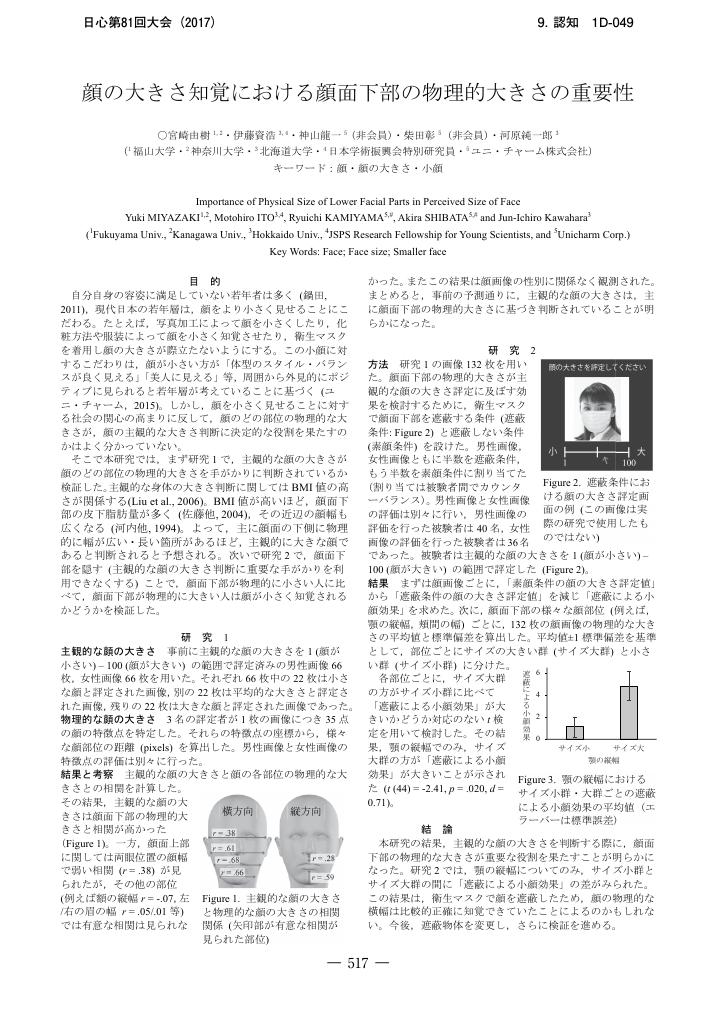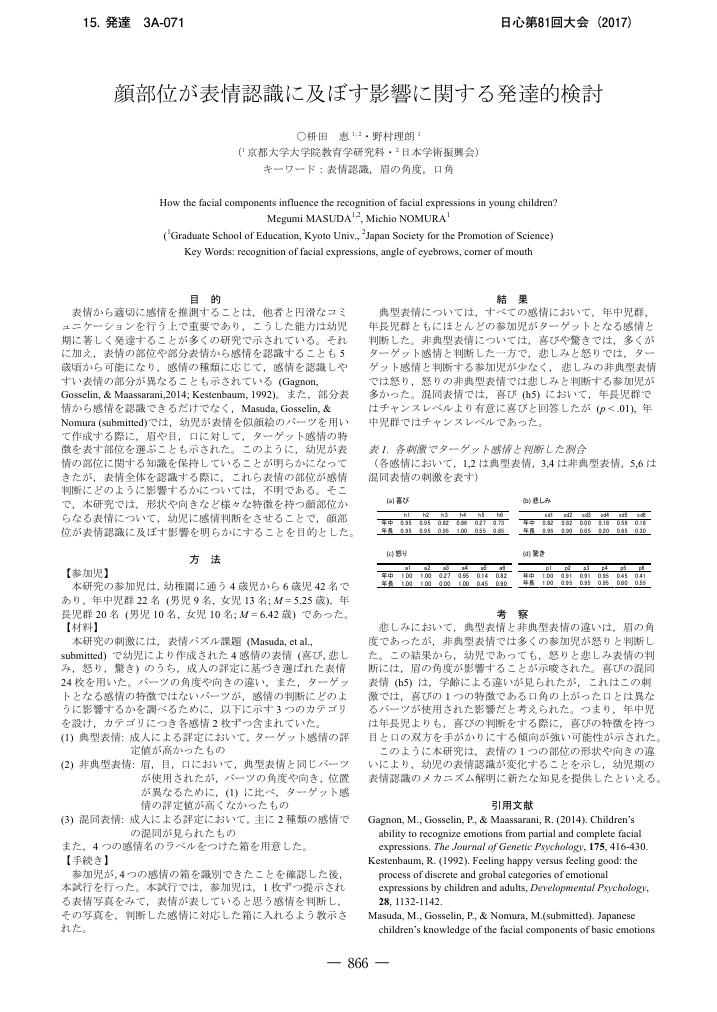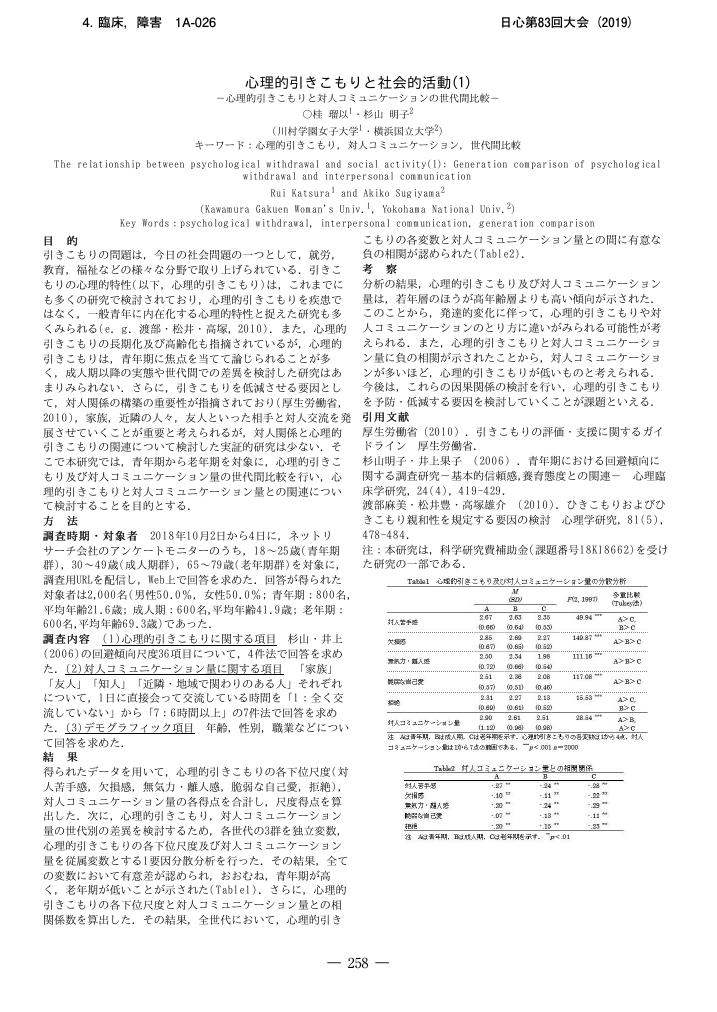1 0 0 0 OA 軽度認知症患者への回想音楽療法の試み(1) ― 気分,および音楽行動の変化に着目して ―
- 著者
- 三雲 真理子 森本 美奈子 安田 晶子 中原 純 山本 泰司
- 出版者
- 公益社団法人 日本心理学会
- 雑誌
- 日本心理学会大会発表論文集 日本心理学会第75回大会 (ISSN:24337609)
- 巻号頁・発行日
- pp.1PM053, 2011-09-15 (Released:2019-02-02)
1 0 0 0 OA 自傷行為への遭遇体験と精神的健康の関連
- 著者
- 田中 大輔 谷 秀次郎 高橋 あすみ 青木 佐奈枝
- 出版者
- 公益社団法人 日本心理学会
- 雑誌
- 日本心理学会大会発表論文集 日本心理学会第79回大会 (ISSN:24337609)
- 巻号頁・発行日
- pp.2PM-035, 2015-09-22 (Released:2020-03-27)
1 0 0 0 OA 顔の大きさ知覚における顔面下部の物理的大きさの重要性
- 著者
- 宮崎 由樹 伊藤 資浩 神山 龍一 柴田 彰 河原 純一郎
- 出版者
- 公益社団法人 日本心理学会
- 雑誌
- 日本心理学会大会発表論文集 日本心理学会第81回大会 (ISSN:24337609)
- 巻号頁・発行日
- pp.1D-049, 2017-09-20 (Released:2020-03-27)
1 0 0 0 OA 音声における音響特性と印象評価との関係
- 著者
- 三雲 真理子
- 出版者
- 公益社団法人 日本心理学会
- 雑誌
- 日本心理学会大会発表論文集 日本心理学会第79回大会 (ISSN:24337609)
- 巻号頁・発行日
- pp.3AM-072, 2015-09-22 (Released:2020-03-27)
1 0 0 0 OA 性格特性の一面性と個人志向性・社会志向性との関運について
- 著者
- 伊藤 美奈子
- 出版者
- 公益社団法人 日本心理学会
- 雑誌
- 心理学研究 (ISSN:00215236)
- 巻号頁・発行日
- vol.65, no.1, pp.18-24, 1994-04-20 (Released:2010-07-16)
- 参考文献数
- 16
- 被引用文献数
- 1
The degree of integration of contrasting traits in the person may be an index of personal maturity. This study examined such an integration process from the framework of individual and social orientedness. Subjects, 118 male and 329 female students, were asked to fill out an orientedness scale, a short version of TSPS: a measure of the two-sidedness of personality, and a self-esteem scale. Results showed that for those high on one-sidedness, individual orientedness turned out to be the sole factor, clearly bisecting those high and low on self-esteem and other traits. High correlations of self-esteem with traits like leadership and activity seem to indicate that the highly one-sided use a single dimension for their judgments. On the other hand, when one-sidedness was low, both individual and social orientedness became necessary, and ratings of personality traits moderate. Self-esteem correlated with flexibility and deliberateness, showing both active and reflective tendencies. As for the orientedness, individual orientedness is related to active traits and self-esteem, while social orientedness correlated with both active and reflective traits, implying moderate characteristics for the person's personality.
1 0 0 0 OA 面接のあり方が目撃した出来事に関する児童の報告と記憶に及ぼす影響
- 著者
- 仲 真紀子
- 出版者
- 公益社団法人 日本心理学会
- 雑誌
- 心理学研究 (ISSN:00215236)
- 巻号頁・発行日
- vol.83, no.4, pp.303-313, 2012 (Released:2013-01-01)
- 参考文献数
- 43
- 被引用文献数
- 12 8
We investigated how different ways of interviewing, i.e., free recall (FR), free recall with context reinstatement (CR), asking misleading questions (Q), or interviewing with open-ended questions (O) affect children's eyewitness reports and their subsequent memory of a viewed event. Participants were 249 eight and ten year-old children. Children were shown a video, and then were interviewed using either FR, CR, Q, or O, followed by an immediate recognition test, and a delayed recall and recognition tests several days later about the event. Results showed that O interviews elicited a greater amount of accurate information than FR, CR, and Q interviews. For older children, CR interviews elicited more accurate information than FR and Q interviews without eliciting inaccurate information. However, for younger children, the subsequent recognition memory for the event was more accurate for children who were interviewed using FR and O. These results suggest that O is the most effective way of conducting investigative interviews with children not only to elicit accurate information but also to keep their memories relatively intact.
1 0 0 0 OA 生徒が自分の関心を行動に移すにはなにが必要か:計画的行動理論とワクワク感による実証研究
- 著者
- 正木 郁太郎
- 出版者
- 公益社団法人 日本心理学会
- 雑誌
- 日本心理学会大会発表論文集 日本心理学会第83回大会 (ISSN:24337609)
- 巻号頁・発行日
- pp.1A-077, 2019-09-11 (Released:2020-09-26)
1 0 0 0 OA 文章理解過程における比喩の役割
- 著者
- 中原 誠
- 出版者
- 公益社団法人 日本心理学会
- 雑誌
- 日本心理学会大会発表論文集 日本心理学会第70回大会 (ISSN:24337609)
- 巻号頁・発行日
- pp.1PM140, 2006-11-03 (Released:2018-07-03)
1 0 0 0 OA 子どもと同居する母親の面会交流の受け止め尺度の信頼性・妥当性の検討
- 著者
- 直原 康光 安藤 智子
- 出版者
- 公益社団法人 日本心理学会
- 雑誌
- 日本心理学会大会発表論文集 日本心理学会第83回大会 (ISSN:24337609)
- 巻号頁・発行日
- pp.2C-003, 2019-09-11 (Released:2020-09-26)
- 著者
- 小林 朋子
- 出版者
- 公益社団法人 日本心理学会
- 雑誌
- 日本心理学会大会発表論文集 日本心理学会第83回大会 (ISSN:24337609)
- 巻号頁・発行日
- pp.1C-083, 2019-09-11 (Released:2020-09-26)
1 0 0 0 OA 日本における遠隔カウンセリングの現状 システマティックレビュー
- 著者
- 竹林 唯 前田 正治
- 出版者
- 公益社団法人 日本心理学会
- 雑誌
- 日本心理学会大会発表論文集 日本心理学会第82回大会 (ISSN:24337609)
- 巻号頁・発行日
- pp.3PM-042, 2018-09-25 (Released:2019-07-19)
1 0 0 0 交感する名刺交換―名刺交換場面を通した性格判断の正確性―
- 著者
- 阿部 里香 荘島 宏二郎 藤 桂
- 出版者
- 公益社団法人 日本心理学会
- 雑誌
- 日本心理学会大会発表論文集
- 巻号頁・発行日
- vol.82, pp.3PM-008-3PM-008, 2018
1 0 0 0 OA 青年の宗教心 信念初發の年齡及び其動機
- 著者
- 石神 徳門
- 出版者
- 公益社団法人 日本心理学会
- 雑誌
- 心理研究 (ISSN:18841066)
- 巻号頁・発行日
- vol.1, no.1, pp.94-103, 1912-01-01 (Released:2010-07-16)
- 参考文献数
- 2
1 0 0 0 OA 因果応報的ストーリーへの期待とその発達―幼児期・学童期に注目して―
- 著者
- 山手 秋穂 橋彌 和秀
- 出版者
- 公益社団法人 日本心理学会
- 雑誌
- 日本心理学会大会発表論文集 日本心理学会第81回大会 (ISSN:24337609)
- 巻号頁・発行日
- pp.2C-078, 2017-09-20 (Released:2020-03-27)
1 0 0 0 OA 顔部位が表情認識に及ぼす影響に関する発達的検討
- 著者
- 枡田 恵 野村 理朗
- 出版者
- 公益社団法人 日本心理学会
- 雑誌
- 日本心理学会大会発表論文集 日本心理学会第81回大会 (ISSN:24337609)
- 巻号頁・発行日
- pp.3A-071, 2017-09-20 (Released:2020-03-27)
1 0 0 0 OA ヘルシー・ディペンデンシーと援助要請風土認知が援助要請におよぼす影響
- 著者
- 池田 亜紗 磯崎 三喜年
- 出版者
- 公益社団法人 日本心理学会
- 雑誌
- 日本心理学会大会発表論文集 日本心理学会第83回大会 (ISSN:24337609)
- 巻号頁・発行日
- pp.3C-009, 2019-09-11 (Released:2020-09-26)
1 0 0 0 OA キャリア多様化の時代におけるプロ人材への変容とキャリア転換?
- 著者
- 宮下 太陽 サトウ タツヤ
- 出版者
- 公益社団法人 日本心理学会
- 雑誌
- 日本心理学会大会発表論文集 日本心理学会第83回大会 (ISSN:24337609)
- 巻号頁・発行日
- pp.2B-018, 2019-09-11 (Released:2020-09-26)
- 著者
- 桂 瑠以 杉山 明子
- 出版者
- 公益社団法人 日本心理学会
- 雑誌
- 日本心理学会大会発表論文集 日本心理学会第83回大会 (ISSN:24337609)
- 巻号頁・発行日
- pp.1A-026, 2019-09-11 (Released:2020-09-26)
1 0 0 0 OA 日本語版3因子レベンソンサイコパシー尺度の作成
- 著者
- 杉浦 光海 杉浦 義典 堀内 孝
- 出版者
- 公益社団法人 日本心理学会
- 雑誌
- 日本心理学会大会発表論文集 日本心理学会第83回大会 (ISSN:24337609)
- 巻号頁・発行日
- pp.1B-003, 2019-09-11 (Released:2020-09-26)
1 0 0 0 OA サイコパシーにおける道徳的態度は学習能力と関係するか?
- 著者
- 大庭 丈幸 片平 健太郎 大平 英樹
- 出版者
- 公益社団法人 日本心理学会
- 雑誌
- 日本心理学会大会発表論文集 日本心理学会第83回大会 (ISSN:24337609)
- 巻号頁・発行日
- pp.2D-005, 2019-09-11 (Released:2020-09-26)














